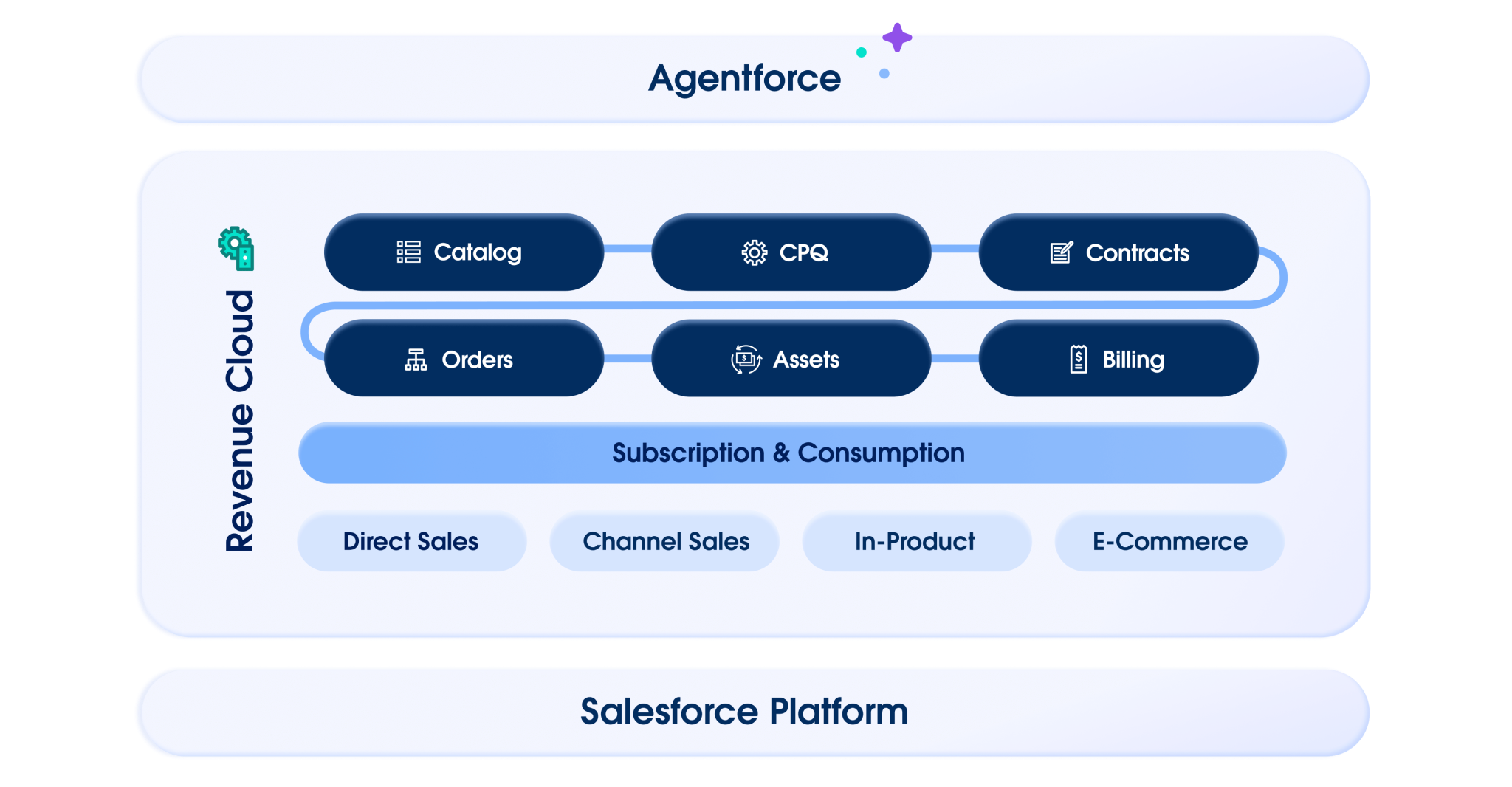Salesforce has confirmed that Salesforce CPQ (Configure, Price, Quote) has entered End of Sale (EOS). This means the legacy CPQ product SKU is no longer available for new customers to purchase. Current customers can continue using it, renew licenses, and receive support, but no new features will be released.
The good news: CPQ functionality is not disappearing. Instead, quoting and configuration have been built directly into Revenue Cloud, Salesforce’s next-generation revenue management platform. With two editions now available, Growth and Advanced, Salesforce customers have options for growth and a clear path forward.
What is Salesforce CPQ?
For more than a decade, Salesforce CPQ has helped sales teams configure products, apply pricing rules, and generate accurate quotes without relying on spreadsheets or manual calculations. It automated approvals, reduced errors, and accelerated the time to quote, becoming an essential tool for many organizations.
The system allowed sales reps to handle complex bundles, apply pricing logic, generate proposals directly inside Salesforce, and manage renewals or amendments. These capabilities simplified the sales cycle considerably, but CPQ’s design also created challenges as businesses looked to expand into subscriptions, usage-based pricing, and omnichannel selling.
Why Salesforce is Moving Beyond the Legacy CPQ Package
The original Salesforce CPQ worked well for quoting, but it was not built to handle the complexity of modern revenue operations. Customers often faced:
- Delays in pricing, contract approvals, and order capture
- Revenue leakage from inaccurate invoicing or missed renewals
- High costs from managing multiple disconnected tools for contracts, billing, and ERP
- Heavy customization to support subscriptions, promotions, and multi-product bundles
- Scalability issues with large quotes or advanced pricing models
Salesforce recognized the need for a unified, native solution that could handle the entire revenue lifecycle, not just quoting. That is why CPQ functionality has been rolled into Revenue Cloud, an end-to-end platform for product-to-cash.
(For context: In their June 2025 article, The Future of Revenue Is Agent-First and Agile, Salesforce confirmed CPQ’s End of Sale status while assuring existing customers it remains fully supported.)
Enter Revenue Cloud
Revenue Cloud brings together quoting, subscriptions, contracts, billing, and analytics into one system built natively on Salesforce core. By embedding CPQ into Revenue Cloud, Salesforce has eliminated the need for heavy integrations and made it easier for businesses to scale, innovate, and adapt to new revenue models.

Revenue Cloud is available in two editions:
Revenue Cloud Growth
- Streamlined quoting and configurator (modern CPQ)
- Subscription management included
- Order capture capabilities
- Lower cost and complexity than Advanced
- Best fit: Organizations that primarily need quoting and subscriptions
Revenue Cloud Advanced (RCA)
- Everything in Growth, plus:
- Contract lifecycle management (CLM)
- Order management and orchestration
- Invoicing and consumption-based billing
- Advanced promotions and pricing waterfall
- Built-in approvals
- Tableau Next dashboards and analytics
- Agentforce AI automation
- Best fit: Enterprises with complex revenue operations or end-to-end quote-to-cash needs.
In short, Growth is the natural successor for most CPQ customers, while Advanced expands into the full revenue lifecycle.
For a detailed breakdown of editions, Salesforce lists current features and pricing on their Revenue Cloud pricing page.CPQ vs. Revenue Cloud: What’s Changing
CPQ as a standalone product is being retired, but CPQ functionality continues as part of the broader Revenue Cloud platform.
Category | CPQ | Revenue Cloud Growth | Revenue Cloud Advanced |
|---|---|---|---|
Quoting | Quote Line Editor | Streamlined quoting | Transaction Line Editor (Excel-style) |
Configuration | Bundle configurator | Modern configurator | Advanced configurator + Constraint Builder |
Pricing | Price rules, QCP plugin | Declarative pricing builder | Advanced pricing engine + promotions |
Subscriptions | Custom asset modeling | Native subscription management | Advanced subscriptions + usage billing |
Contracts | Requires integrations (e.g. Cong Composer) | ❌ | ✅ Native CLM included |
Billing | Requires Salesforce Billing add-on | Basic billing included | Advanced invoicing + RCA Billing |
Approvals | Advanced Approvals add-on | Built-in Flow Orchestration | Built-in Flow Orchestration |
Analytics | Manual reporting | Limited | Tableau Next dashboards |
Innovation | Maintenance only | Actively developed | Actively developed |
Revenue Cloud = More Than Just Quoting
The legacy CPQ product was primarily a sales tool. Reps and admins configured products, applied pricing rules, and generated proposals. Revenue Cloud, by contrast, is an enterprise-wide platform that connects Sales, Operations, Finance, Legal, and Service teams in one system.
By embedding CPQ into Revenue Cloud, Salesforce has shifted from a sales-focused application to a cross-functional revenue platform that supports the entire product-to-cash lifecycle.
What Customers Should Do Now
If you are a current CPQ customer, here is how to prepare:
Review your CPQ setup. Document how you use CPQ today, including pricing rules, product bundles, approvals, and customizations.
Evaluate Growth vs. Advanced
If you mainly need quoting and subscriptions, Growth may be the right fit.
If you also require contracts, billing, or advanced analytics, Advanced is designed for you.
Talk to Salesforce or a partner. Confirm licensing options, upgrade incentives, and migration considerations.
Plan your roadmap. Even if you are not migrating immediately, planning now ensures you will not be caught off guard when Salesforce eventually sets an End of Life date* for the legacy CPQ package.
How Rithom Can Help
At Rithom Consulting, we work with Salesforce customers every day to modernize their revenue operations. We can help you:
Assess your readiness – understand how your current CPQ setup maps to Growth or Advanced.
Design your roadmap – build a phased migration plan that minimizes disruption.
Migrate with confidence – ensure your product catalog, pricing, and contract data transition smoothly.
Optimize for the future – unlock the power of Revenue Cloud’s automation, analytics, and AI.
Whether you are ready to act today or simply exploring your options, Rithom is here to guide you through the next chapter of Salesforce revenue management.
Learn more about our Revenue Cloud services or let’s talk about your CPQ roadmap today.
